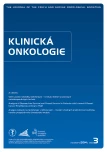Cost Analysis of Radiotherapy Provided in Inpatient Setting – Testing Potential Predictors for a New Prospective Payment System
Authors:
J. Šedo 1; M. Bláha 2; T. Pavlík 2; P. Klika 2; L. Dušek 2; T. Büchler 3; J. Abrahámová 3; V. Šrámek 4; P. Šlampa 5
; L. Komínek 5; P. Pospíšil 5
; O. Sláma 1; R. Vyzula 1
Authors‘ workplace:
Klinika komplexní onkologické péče LF MU a Masarykův onkologický ústav, Brno
1; Institut biostatistiky a analýz, LF a PřF MU, Brno
2; Onkologická klinika 1. LF UK a Thomayerova nemocnice, Praha
3; Onkologická klinika LF UP a FN Olomouc
4; Klinika radiační onkologie LF MU a Masarykův onkologický ústav, Brno
5
Published in:
Klin Onkol 2014; 27(3): 192-202
Category:
Original Articles
Overview
Background:
As a part of the development of a new prospective payment model for radiotherapy we analyzed data on costs of care provided by three comprehensive cancer centers in the Czech Republic. Our aim was to find a combination of variables (predictors) which could be used to sort hospitalization cases into groups according to their costs, with each group having the same reimbursement rate. We tested four variables as possible predictors – number of fractions, stage of disease, radiotherapy technique and diagnostic group.
Methods:
We analyzed 7,440 hospitalization cases treated in three comprehensive cancer centers from 2007 to 2011. We acquired data from the I‑ COP database developed by Institute of Biostatistics and Analyses of Masaryk University in cooperation with oncology centers that contains records from the National Oncological Registry along with data supplied by healthcare providers to insurance companies for the purpose of retrospective reimbursement.
Results:
When comparing the four variables mentioned above we found that number of fractions and radiotherapy technique were much stronger predictors than the other two variables. Stage of disease did not prove to be a relevant indicator of cost distinction. There were significant differences in costs among diagnostic groups but these were mostly driven by the technique of radiotherapy and the number of fractions. Within the diagnostic groups, the distribution of costs was too heterogeneous for the purpose of the new payment model.
Conclusion:
The combination of number of fractions and radiotherapy technique appears to be the most appropriate cost predictors to be involved in the prospective payment model proposal. Further analysis is planned to test the predictive value of intention of radiotherapy in order to determine differences in costs between palliative and curative treatment.
Key words:
health care costs – radiotherapy – radiation oncology – prospective payment system – reimbursement mechanisms – diagnosis-related groups
This study was supported by Institutional Resources for Supporting the Research Organization provided by the Ministry of Health of the Czech Republic to Masaryk Memorial Cancer Institute and from European Social Fund, project „Educational and informative platform for comprehensive cancer centers for support and modernization of education in medical and allied domains“ CZ.1.07/2.4.00/31.0020.
The authors declare they have no potential conflicts of interest concerning drugs, products, or services used in the study.
The Editorial Board declares that the manuscript met the ICMJE “uniform requirements” for biomedical papers.
Submitted:
15. 12. 2013
Accepted:
5. 1. 2014
Sources
1. Šedo J. DRG v praxi 2013: Seznámení s českou implementací úhradového systému DRG. Praha: Galén 2013.
2. Jegers M, Kesteloot K, De Graeve D et al. A typology for provider payment systems in health care. Health Policy 2002; 60(3): 255– 273.
3. Ellis RP, McGuire TG. Insurance principles and the design of prospective payment systems. J Health Econ 1988; 7(3): 215– 237.
4. Ellis RP, McGuire TG. Optimal payment systems for health services. J Health Econ 1990; 9(4): 375– 396.
5. Schreyögg J, Stargardt T, Tiemann O et al. Methods to determine reimbursement rates for diagnosis related groups (DRG): a comparison of nine European countries. Health Care Manag Sci 2006; 9(3): 215– 223.
6. Hope – European Hospital and Healthcare Federation [homepage on the Internet]. HOPE report on DRGs as a financing tool, 2006. Available from: http:/ / www.hope.be/ 05eventsandpublications/ docpublications/ 77_drg_report/ 77_drg_report_2006.pdf.
7. Lievens Y, Van den Bogaert W, Rijnders A et al. Palliative radiotherapy practice within Western European countries: impact of the radiotherapy financing system? Radiother Oncol 2000; 56(3): 289– 295.
8. Kožený P, Němec J, Kárníková J et al (eds). Klasifikační systém DRG. 1. vyd. Praha: Grada 2010.
9. I‑ COP EDU [homepage on the Internet]. Edukační a informační platforma onkologických center pro podporu a modernizaci vzdělávání v lékařských a příbuzných medicínských oborech [cited 2013 December 7]. Available from: http:/ / www.icop.cz/ .
10. Blaha M, Janča D, Klika P et al. Project I‑ COP – architecture of software tool for decision support in oncology. In: Data and Knowledge for Medical Decision Support. Amsterdam: IOS Press 2013: 186: 130– 134.
11. Büchler T, Nohejlová Medková A, Kupec M et al. Porovnání nákladů u režimů XELOX a FOLFOX‑ 4 v léčbě kolorektálního karcinomu. Klin Onkol 2012; 25(6): 440– 444.
Labels
Paediatric clinical oncology Surgery Clinical oncologyArticle was published in
Clinical Oncology

2014 Issue 3
- Metamizole vs. Tramadol in Postoperative Analgesia
- Metamizole at a Glance and in Practice – Effective Non-Opioid Analgesic for All Ages
- Possibilities of Using Metamizole in the Treatment of Acute Primary Headaches
- Current Insights into the Antispasmodic and Analgesic Effects of Metamizole on the Gastrointestinal Tract
- Spasmolytic Effect of Metamizole
Most read in this issue
- Very Late Effects of Radiotherapy – Limiting Factor of Current Radiotherapy Techniques
- Inverted Papiloma and Its Rare Forms
- Cancer in Elderly
- Case Report of a Patient with Advanced and Disseminated Gastric Carcinoma Treated by S-1
